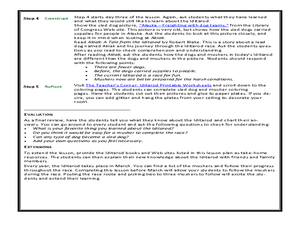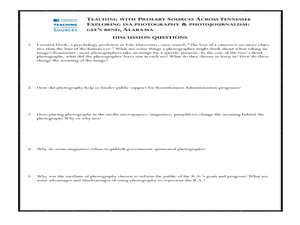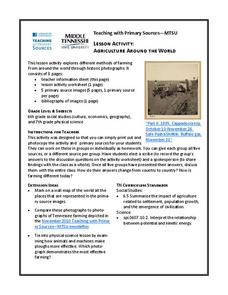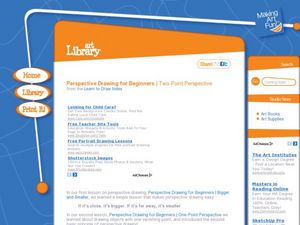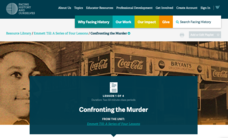Facing History and Ourselves
Eyes on the Prize Lesson 2: Six Steps for Nonviolent Social Change
High schoolers explore the concept of nonviolent protest. For this Civil Rights instructional activity, students examine the attributes of nonviolent protest as they investigate the student protests that took place in Nashville in...
Facing History and Ourselves
Exploring Raphael Lemkin's Actions: The Invention of the Word "Genocide"
Learners examine the contributions of Raphael Lemkin. For this genocide activity, students consider how Lemkin defined the atrocities of the Holocaust as he coined the term "genocide." Learners discuss the definition of genocide as well...
Curated OER
Web of Life Game: Trout
Students explore the concept of food webs. In this food web lesson plan, students demonstarte the connection between species. Students use a ball of string show how the food web works, then have a class discussion.
Curated OER
Trout Are Made of Trees Crayon Mural
Students recognize that for a trout habitat to be ideal, several components must be present. In this trout lesson, students explore what makes a healthy stream. Students create paintings for a mural of a trout habitat....
Curated OER
The Iditarod: The Last Great Race
Students investigate the Iditarod. In this last great race instructional activity, students explore and research the Iditarod race which takes place in Alaska. Students explore a variety of websites and images to gather background...
Curated OER
A More Perfect Union: Women's Suffrage and the Constitution
Students reflect on the pros and cons of Women's Suffrage and it was viewed during the late 1800's. In this history lesson, students will analyze documents on women's suffrage so that they can compare and contrast the rights of...
Curated OER
Teaching with Primary Sources Across Tennessee
Students examine Gee's Bend Alabama. In this resettlement lesson, students view a series of photographs taken of Gee's Bend Alabama. Students will write a series of newspaper articles based on the images, that exemplify the evolution of...
Curated OER
Agriculture Around the World
Students explore various kinds of farming methods around the world. For this history lesson, students view pictures of farming methods, then compare and contrast them in a class discussion with the methods of farming that are used...
Curated OER
Does Negative Space Have A Shape?
Students observe negative space in drawing. In this negative space instructional activity, students discover that sketches include negative space or background. Students produce a drawing while paying attention to the negative space.
Curated OER
Draw A Face
Young scholars discover how to sketch a face. In this sketching instructional activity, students explore the steps to construct a facial drawing. Spacing and symmetry of facial features are explored.
Curated OER
The Basic Shapes of Everything
Students explore basic shapes in art. In this sketching lesson, students discover that art is created from basic shapes. Students determine the basic shapes in a picture and recreate the image.
Curated OER
Perspective Drawing for Beginners
Students explore one point perspective. In this perspective activity, students discover how to create illustrations with vanishing points. Students create an original piece of art.
Curated OER
Perspective Drawing for Beginners-Two Point Perspective
Students inspect two point perspective. In this perspective instructional activity, students explore drawing with two vanishing points. Students create an original piece of art using two point perspective.
Curated OER
The Tobacco Time Bomb: What's In A Cigarette?
In this enlightening and disturbing health lesson, young scholars read and discuss information on smoking and closely-look at the ingredients in a cigarette. You will be amazed at the list of ingredients that are found in cigarettes....
Curated OER
Crazy Chemistry Lesson Plan
Students study water molecules, cohesion and surface tension. In this molecule cohesion lesson students create chemical reactions that cause a balloon to inflate and another one that results in soap suds.
Facing History and Ourselves
Emmett Till: Confronting the Murder
The 1955 murder of Emmett Till is often regarded as the catalyst for the Civil Rights Movement of the 20th century. Learn more about the brutal crime—and, as many believe, the miscarriage of justice—that began a national conversation...
Facing History and Ourselves
Who Am I?
Sixth graders explore how people throughout time have responded to questions regarding identity. For this The House on Mango Street lesson, 6th graders create an identity chart for a fictional character and then write personal essays...
Facing History and Ourselves
Denial and Free Speech
Learners explore the meaning and implications of genocide. For this Armenian genocide activity, learners investigate the genocide that took place in Turkey.
Curated OER
Nation Building
Ninth graders examine the role of the United States in nation building. In this World History activity, 9th graders evaluate the role of the United States in building nations in other parts of the world.
Facing History and Ourselves
How Do Rules and Traditions Shape Communities?
Sixth graders explore the concepts of laws and customs in a community, examining the reasoning behind rules. Then then collaborate to write their own classroom code of conduct.
Facing History and Ourselves
What Shapes Your Identity?
Sixth graders explore their individual identities. For this personal identity lesson, 6th graders write biopoems using the provided template. Students share their poems and respond to the poetry shared.
Facing History and Ourselves
How Do Others Define Your Identity?
Sixth graders examine the relationship between the individual and society. In this World History lesson, learners read a book that discusses labels put on individuals. Students create a story board in relation to...
Facing History and Ourselves
What Aspects of Our Identities Do We Show to Others?
Sixth graders consider how they present their personal identities. For this character education lesson plan, 6th graders define themselves as they create masks that represent their personalities. Students share their masks and discuss...
Facing History and Ourselves
Who Are We?
Sixth graders explore the diversity of communities. In this community-building lesson, 6th graders compose biopoems and create a classroom exhibit entitled "Who am I? Who are We?"
Other popular searches
- The Library of Congress
- Map of a Library
- End of Year Library Activities
- Purpose of Classroom Library
- Photo of School Library




